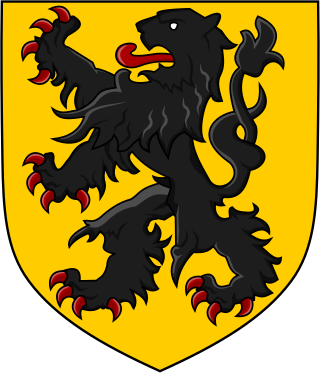
Arnulf I, called "the Great", was the first Count of Flanders.
The County of Aumale, later elevated to a duchy, was a medieval fief in Normandy, disputed between France and England during parts of the Hundred Years' War.

The County of Boulogne was a county within the Kingdom of France during the 9th to 15th centuries, centred on the city of Boulogne-sur-Mer. It was ruled by the counts of Flanders in the 10th century, but a separate House of Boulogne emerged during the 11th century. It was annexed by Philip II of France in 1212, after which it was treated as part of the county of Artois until it was finally annexed into the royal domain in 1550.
Matilda was Countess of Boulogne in her own right from 1125 and Queen of England from the accession of her husband, Stephen, in 1135 until her death in 1152. She supported Stephen in his struggle for the English throne against their mutual cousin Empress Matilda. She played an unusually active role for a woman of the period when her husband was captured, and proved herself an effective general who managed to force the Empress to release Stephen. Under the agreement that settled the civil war, the Queen's children did not inherit the English throne; however, her three surviving children ruled Boulogne in turn as Eustace IV, William I, and Marie I.

William I, also referred to as William of Blois, was Count of Boulogne and Earl of Surrey jure uxoris from 1153 until his death. He was the second son of Stephen, King of England, and Matilda I, Countess of Boulogne.
Marie I or Mary was the suo jure Countess of Boulogne from 1159 to 1170. She also held the post of Abbess of Romsey for five years until her abduction by Matthew of Alsace, who forced her to marry him. She is one of several possible identities of the author Marie de France.

Mahaut or Matilda II of Boulogne was Countess of Boulogne in her own right and Queen of Portugal by marriage to King Afonso III from 1248 until their divorce in 1253. She was the daughter of Ida, Countess of Boulogne and her husband and co-ruler Renaud, Count of Dammartin. She succeeded her mother as Countess of Boulogne in 1216. She was the great-granddaughter of King Stephen of England.

Philip I of Boulogne (1200–1235) was a French prince, Count of Clermont-en-Beauvaisis in his own right, and Count of Boulogne, Mortain, Aumale, and Dammartin-en-Goële jure uxoris.

Renaud de Dammartin was Count of Boulogne from 1190, Count of Dammartin from 1200 to 1214 and Count of Aumale from 1204 to 1214. He was son of Alberic III of Dammartin and Mathilde of Clermont.
The Battle of Cassel was fought in February 1071 between Robert I of Flanders and his nephew, Arnulf III. The battle was a victory for Robert, and Arnulf was killed in the battle.
Events from the 1150s in England.
The crown lands, crown estate, royal domain or domaine royal of France were the lands, fiefs and rights directly possessed by the kings of France. While the term eventually came to refer to a territorial unit, the royal domain originally referred to the network of "castles, villages and estates, forests, towns, religious houses and bishoprics, and the rights of justice, tolls and taxes" effectively held by the king or under his domination. In terms of territory, before the reign of Henry IV, the domaine royal did not encompass the entirety of the territory of the kingdom of France and for much of the Middle Ages significant portions of the kingdom were the direct possessions of other feudal lords.
Adelolf, Count of Boulogne, was a younger brother of Arnulf I, Count of Flanders and was granted the County of Boulogne by his father.

Baldwin II of Boulogne was a son of Arnulf III, Count of Boulogne, whom he succeeded as count of Boulogne.

The House of Flanders, also called the Baldwins, was a medieval ruling family of Frankish origin that was founded by Baldwin Iron Arm, son-in-law of Charles the Bald. The House of Flanders was the first dynasty to transform a county function of the Carolingian Empire into a hereditary fiefdom, the County of Flanders, falling under West Francia, created by the Treaty of Verdun in 843.

Baldwin III, Count of Guînes (1198–1244) was a Flemish nobleman. He inherited the war-torn County of Guînes, now in northern France, while Philip II of France was still on the throne and suffered the repercussions of Philip's expansion of the French state. He is now best known as a mercenary leader in the Welsh Marches, employed by Henry III of England in 1233–1234; the family connections with properties held in England was longstanding.
The Counts of Dammartin were the rulers of the county of Dammartin, based in the current commune of Dammartin-en-Goële as early as the 10th century. Located at the central plain of France, the county controlled the roads of Paris to Soissons and Laon. It seems that this county was initially held by Constance, the wife of Manasses Calvus, the first Count. The name Dammartin-en-Goële comes from Domnus Martinus, the Latin name of St. Martin of Tours, who evangelized the region of Goële in the fourth century. A small town in the district of Meaux in the Department of Seine-et-Marne, ancient village of Region of Île-de-France, it appears to go back to the earliest times; Dammartin-en-Goële, also called Velly, was in 1031 one of the most significant places in France.

The Capetian–Plantagenet rivalry was a series of conflicts and disputes that covered a period of 100 years (1159–1259) during which the House of Capet, rulers of the Kingdom of France, fought the House of Plantagenet, rulers of the Kingdom of England, over the Plantagenet-held Angevin Empire which at its peak covered around half of the territory within France. Some historians refer to this series of events as the "First Hundred Years' War".

















